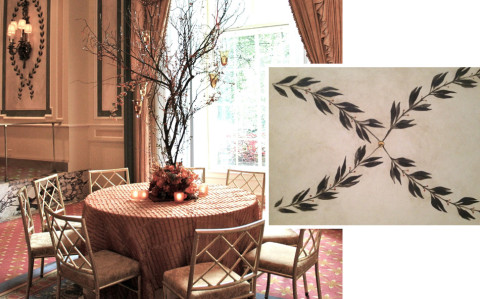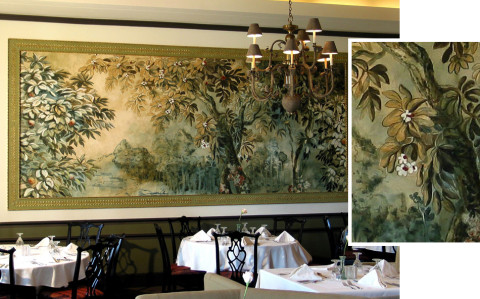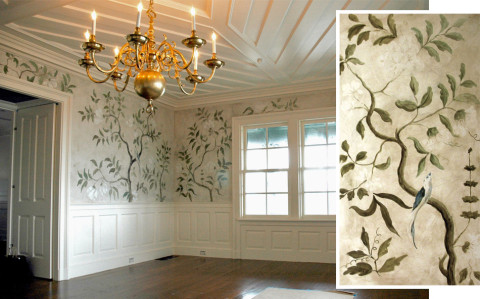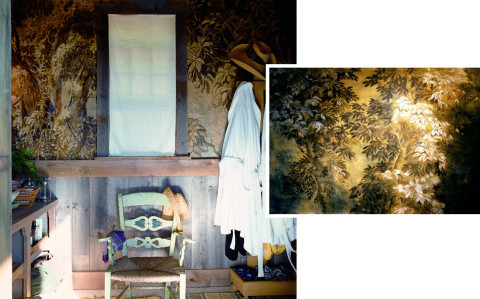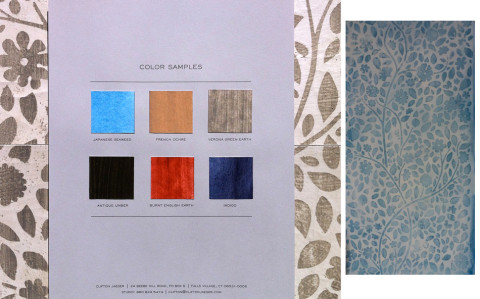
May 29, 2013Clifton Jaeger combines old-world techniques and inspiration to paint decorative murals for clients and decorators around the world. All photos courtesy of Clifton Jaeger
Clifton Jaeger is a prolific muralist and skilled architectural designer, but he also could be considered a historian. What excites him most about his work — whether a Nantucket dining-room mural featuring 17th-century Swedish tree motifs or the Alhambra-inspired courtyard floor of a Moorish-style house in Mexico — are the historic references, techniques and materials at his disposal. “I love the research aspect of each project,” Jaeger explains. “For me, that really is the payoff.”
For inspiration, the Connecticut-based Jaeger digs through centuries of art and design in museums and historic sites around the world. At the Museum of Archeology in Istanbul, for instance, an ancient Greek chain motif led Jaeger to create a hand-painted ceiling border in the dining room of another Mexico project, a residence in San Miguel de Allende.
In addition to the diverse visual references that he combines with his own romantic style, Jaeger uses natural pigments that muralists used in centuries past. “I work with the paint the Romans used,” says Jaeger, who loves the Old-World effect those colors exude. Jaeger obtains the nontoxic natural pigments, which come in powder form, from Kremer Pigments in New York, which is known to comb the world for the perfect colors, from Japan for a shade of blue derived from local seaweed, to France for a particular chalk that is the ideal cream hue. The result is work that exudes a timeless, dreamy quality.

Glimpses of Jaeger’s Connecticut studio reveal, among other works-in-progress, his new collection of wall coverings.

Jaeger worked with Robin Bell, one of several designers with whom he frequently collaborates, on the elegant bathroom she designed for the 2005 Kips Bay Decorator Show House.
Raised in the Caribbean and Manhattan, Jaeger, now 48, is based in the sleepy town of Falls Village, Connecticut, where he works from his sunlit studio in an 18th-century former church. Jaeger, who also creates top-to-bottom residential and commercial design through his architectural design practice, began painting as a young child. He says he hid out in the art studio during much of high school, and he had his first show of landscapes at 16, in a Florida bank one summer. “Every piece sold, and I had $1,200 in my pocket. It had a tremendous impact on me,” says Jaeger, who realized then that art could viably be a career. After graduating from RISD, he made creativity his life’s work.
As a muralist, Jaeger has worked with top designers including Miles Redd, Bunny Williams and Susan Ferrier, creating pieces for every room of the house, from the bathroom to the ballroom, ranging in style from contemporary to traditional. For a Kips Bay Decorator Show House, he collaborated with Robin Bell on a light-filled master bathroom she designed with a sophisticated urban woman in mind. Inspired by a pattern on one of his daughter’s dresses and a Mongolian tapestry with a similar motif, Jaeger rendered his own take on the design in black and white paint on the walls, amping up the scale for a cool, graphic effect. On the more traditional end of the spectrum, Jaeger created a painting for Canyon Ranch in Lenox, Massachusetts, inspired by a variety of flora and fauna in Aubusson tapestries. Thanks to the ancient pigments and his classical rendering of the trees, the painting looks like it could have hailed from the 17th century.

“I work with the same paint the Romans used,” says Jaeger, who uses natural, powdered pigments to give his work a timeless, bygone look.
While it varies by project, Jaeger’s process is long and labor intensive, lasting anywhere from one to six months. He begins by looking at a space and consulting with the client or the designer. Once the direction is decided, he begins researching. He then creates a to-scale watercolor of the artwork in a small 3-D model of the space. In a Nantucket dining room he did for Bunny Williams, for example, he began by applying five coats of gesso to a linen canvas, letting it harden and crack to create a textured surface. Next, he used a combination of stencils and pencil to sketch out his design. He spent weeks filling in the outlines with a custom palette, layering paint for the desired magical effect. For the final glaze, Jaeger rubbed a green-henna varnish to add a tactile, rough finish. He then applied the panels to the wall with adhesive.
What is most captivating about Jaeger’s work is its ability to transport. With their large scale, layered brushwork, and often classical or global subject matter, his pieces give the viewer the feeling of having stepped into another era or region. “I think our environments really affect us,” says Jaeger, pondering the impact of his murals. “I work backwards from the experience that I want people to have looking at it, whether it is relaxed or sublime, and then I go from there. I love transforming a space.”
Clifton Jaeger’s Projects

